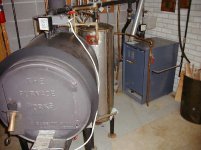Howard,
You dont have to fear a woodstove,as long as you are sure,you have a safe hookup.I have burned wood all my adult life,and my folks did when i was younger.You need first a safe hook up.Follow all your local codes,and im sure your state has info on suggested safe techniques.Have your local fire chief work with you on this one.A good ,lined chimmney ,independant from other furnaces etc,is a requirement,in most places.The metal bestos chimmneys are just as safe in my opinion,size it according to your stove size.Never go reduce to a smaller size.In my opinion a chimmney should be safe enough to withstand a fire,without catching the house on fire...keep that in mind. a chimmney should have a cleanout,so you can inspect them,i do mine monthly.
CLEARANCES
TWO TYPES COME TO MIND:
A double wall stove,with a seperate box around the initial stove,these are safe.Awonder wood brand is a common one.THESE ARE CIRCULATING STOVES
the second type is a RADIATING STOVE ,thus with no second box.
both still need the reccomended clearances.Even if you have the so called fire resistant drywall,the studs behind it still get hot.In MAINE you must have 36 inchs to a combustable item[wall,etc]If you reduce these clearances space the tin or what ever out from the combustable wall with ceramis fence insulaters,one inch air space behind it.I myself built a 3 sided tin box around my stove,i got it about 6 inchs away from the stove.I dont have to worry about the walls getting hot.I also have a ceiling fan near by to push it around.
now lets talk about stovepipe.it should be 24 gage or btr It
should pass through 18 inchs of non combustable material,
Where a stovepipe passes through a wall its 18 inchs. Use as little pipe as possible ,before it goes straight up,no more than 2 bends reccomended[better draft that way. Chimmneys ought to be at least 2 inchs higher[minimum] than the peak of the building for best draft.
Dry wood is important,it doesnt run creasote,MAKE sure its hardwood and dry. Soft wood will soot up your chimmney,Green wood will creasote your chimmney.If you dont have either poplar will do neither,it will not dirty your chimmney,but it dont last long,and it will not make a bed of coals.I always have a cord of it on hand to burn on the semi warm days in the fall and spring,it warms the house,and doesnt leave hot coals to drive you out .I cut my wood a year ahead and partially dry it outside,then teir it in my shed with lots of airspace.Dont split it too small,you want some all nighters,and alldayers.One of them magnetic flue temp gauges will help you learn how to run your stove safetly,and with less creasote...its a gotta have in my book.
DONT FORGET TO PROTECT THE FLOOR
DONT FORGET THE SMOKE ALARMS and mabey co2 tester,FIRE EXSTINGUISHER
A stove in the north end of the house will work the best,Its hard to push heat north,especially without power
As far as stoves i like ones with ash pans.Dont forget to empty them,a stove needs air to work.It also will warp your grates if they get too hot,keep the ashs down...dispose of properly
STOVE,Im partial to the SHENANDOAH with the auto dampers.It also comes down to HOW MUCH DO YOU WANT TO SPEND?Wood burning isnt cheap to get set up and you said you have a supply of wood...good,or i wouldnt do it.
WOULDNT IT BE EASIER TO BUY A HOUSEHOLD GENERATOR/ /forums/images/graemlins/grin.gif /forums/images/graemlins/grin.gif
Some of this info came from the MAINE WOOD BURNING GUIDE..some from my head.Like i said if its safe,its not a worry,the fire chief is your best friend on this one GOOD LUCK
ALAN
